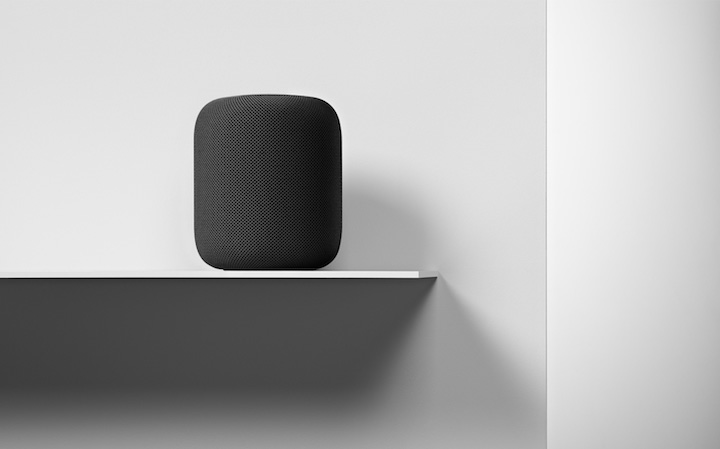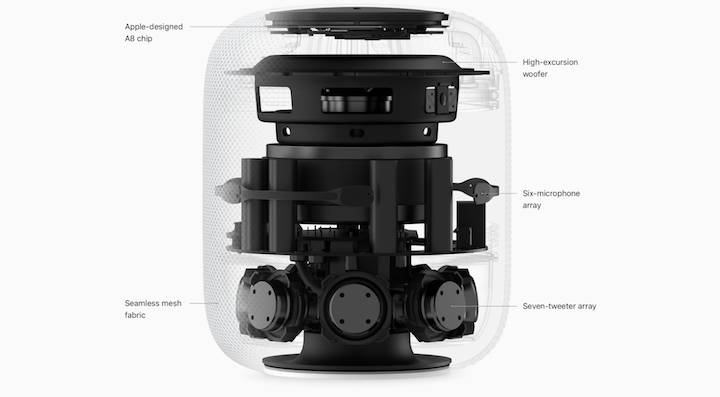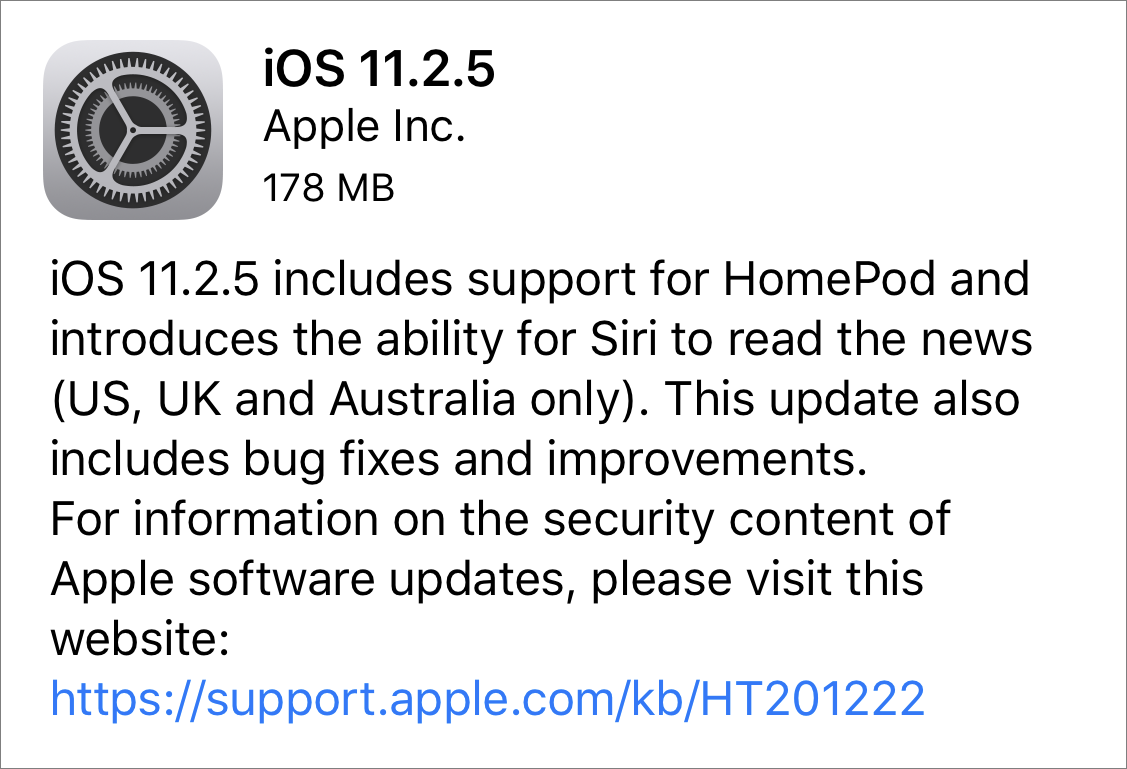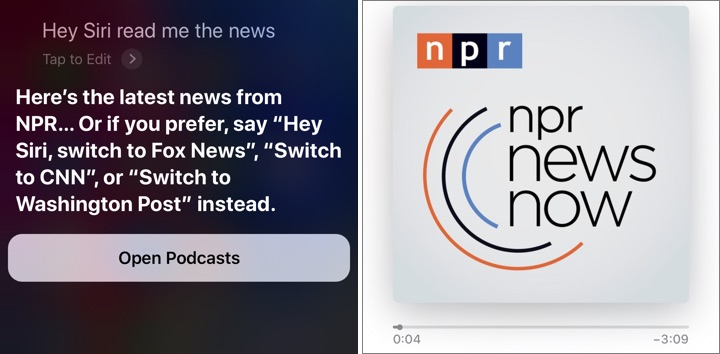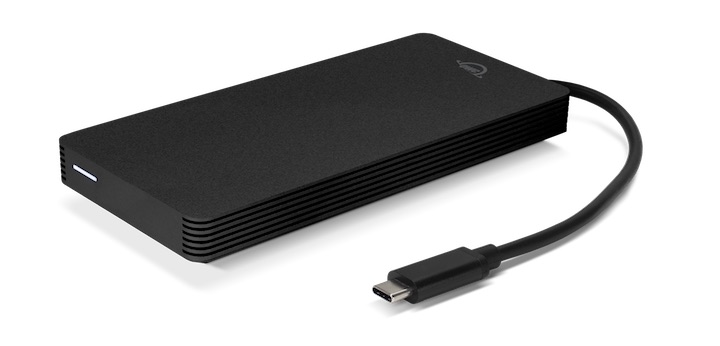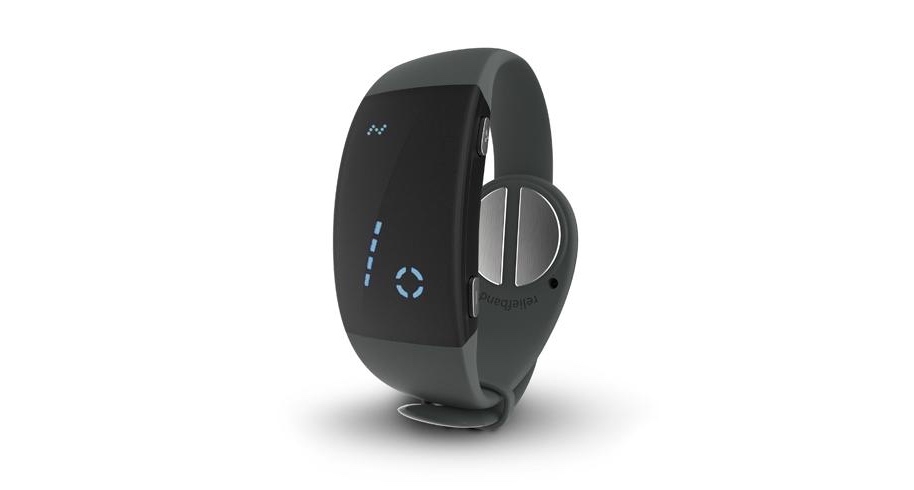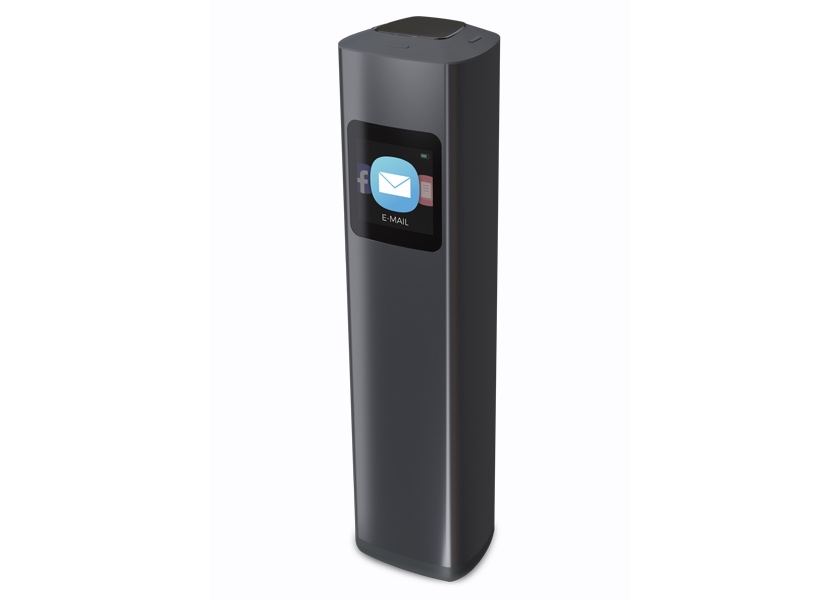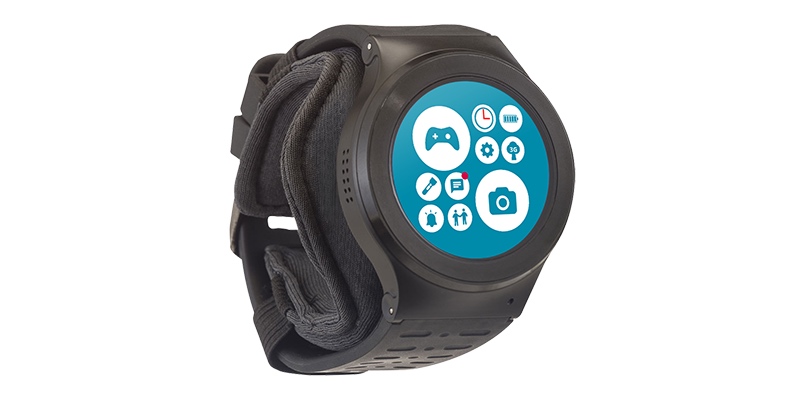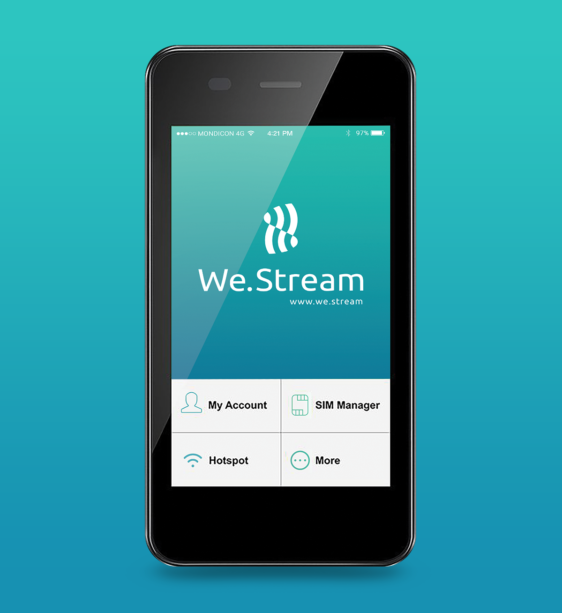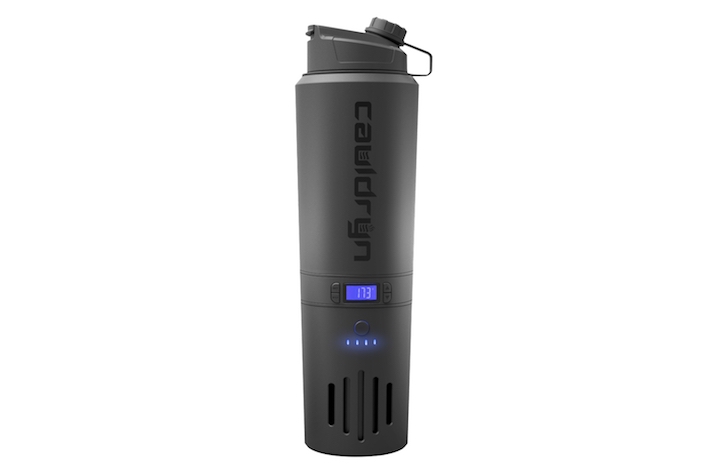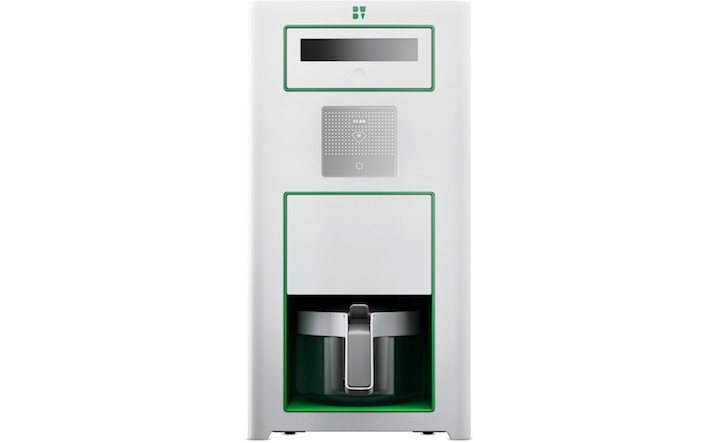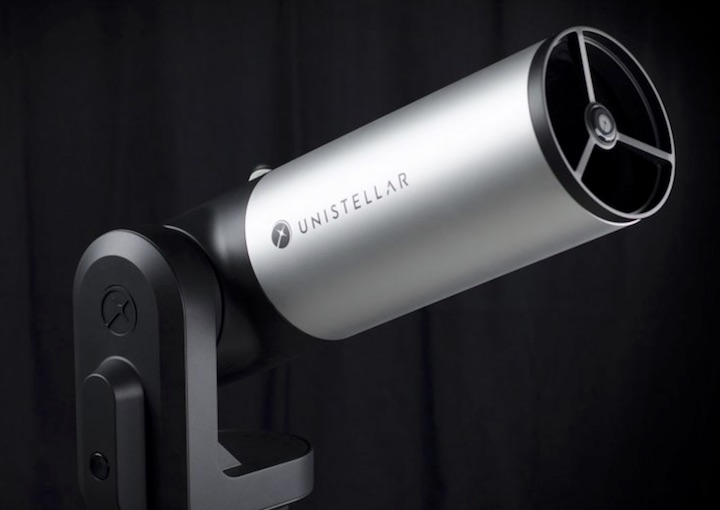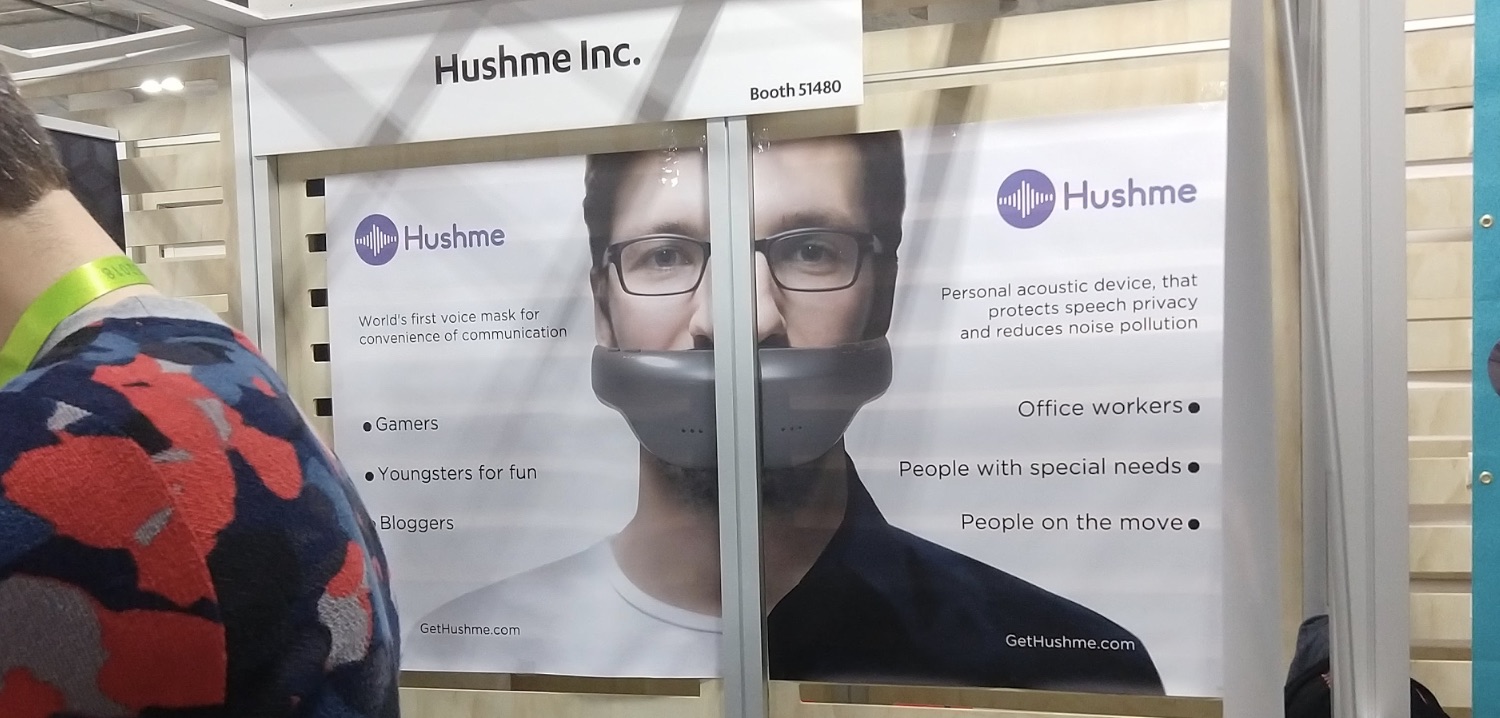#1402: CES 2018, HomePod date, macOS Server deprecated, minor OS updates, iOS 11.3 preview
We have a giant-sized issue of TidBITS for you this week, as we wrap up Jeff Porten’s coverage of CES 2018. But there’s lots more to read as well, since Apple has been showering us with news: an official launch date for the HomePod smart speaker, an announcement deprecating many macOS Server features, updates for all four of the company’s operating systems, and a preview of the upcoming iOS 11.3. Notable software releases this week include BusyCal 3.2.8, Bookends 13.0.5, Logic Pro X 10.4, macOS Server 5.5, iTunes 12.7.3, Safari 11.0.3, and Security Update 2018-001 (Sierra and El Capitan).
HomePod Arrives February 9th, Multi-Room Audio to Follow Later in 2018
Apple’s much-anticipated HomePod smart speaker will arrive on 9 February 2018, and you can pre-order it now in the United States, United Kingdom, and Australia. Unlike many other products where Apple can’t keep up with demand, there’s still no shipping delay on orders placed even now, three days after pre-orders opened. Apple says the HomePod will arrive in France and Germany this spring, but the company made no mention of Canada or other countries. It costs $349 in white or space gray.
If you’re expecting the HomePod to blow away the smarts of the Amazon Echo or Google Home, prepare to be disappointed. From what we know about the HomePod, it will not be able to access third-party services without tapping into a connected iPhone or iPad via SiriKit, unlike the Echo, which lets you install new “skills” on the device. And while the Echo currently offers multi-room audio, the HomePod won’t be able to link speakers together for stereo sound and multi-room audio until later this year. Similarly, AirPlay 2, promised in June 2017 at
WWDC, is still described as “coming later this year.” Business Insider has a list of other things the HomePod can’t do, including recognizing multiple users.
So what’s the sales pitch for the HomePod? Apple is focusing on sound quality, touting its seven-tweeter array and high-excursion woofer. (Excursion is defined as how far the cone of a speaker travels from its resting position.) The HomePod also features six microphones and an A8 chip to decipher your voice.
Apple also touts the HomePod’s integration with Apple services like Apple Music and HomeKit, with which it will be able to interact directly. Also, the HomePod can serve as a HomeKit hub, much like the Apple TV and iPad.
The HomePod will not require an Apple Music subscription, but you’ll probably want one to take full advantage of the HomePod. If you choose to abstain, you can still ask Siri to play purchased iTunes music, podcasts, and stream the Beats 1 radio station. But it appears that the HomePod does not support Home Sharing, and thus on its own can only play music that you purchased through the iTunes Store. For everything else, you will be able to use AirPlay to play audio to the HomePod from any Mac or iOS device, just like an Apple TV or AirPort Express. At iMore, Serenity Caldwell has a full rundown on what the
HomePod can and cannot play.
One thing we now know more about is the tiny display on the top — it’s purely for Siri feedback and manual interaction. Apple has published a guide to the HomePod’s touch controls.
Perhaps Apple would prefer that you think of the HomePod as less of its answer to the Amazon Echo and more of an AirPod for your home. If so, that’s going to be a tough sell with Apple’s current messaging. It also feels strange to try to sell a mono speaker primarily on sound quality. Apple fans and audiophiles are tough crowds, and the subset of people who fall into both groups even more so.
Siri was well ahead of the competition when Apple re-launched it in 2011, but now it’s falling behind, as you could see at this year’s CES, in which Alexa was crammed into every device imaginable (and probably some that would tax the imagination; see “HomeKit Hardware to Expect in 2018,” 19 January 2018).
Throughout the Apple community, excitement for the HomePod seems muted. As developer Marco Arment said, “Nothing about the HomePod release shows Apple’s confidence in it, which makes it hard for any of us to get excited about it.”
Even Daring Fireball’s John Gruber seems skeptical:
How does this handle multiple people in the same home? That seems like a big question to remain unanswered before folks start plunking down $349. This feels like if Apple had started selling the iPod back in 2001 without ever having explained how the click wheel worked or how you synced music to it from iTunes, and instead just said: “Trust us, it’s great.”
Ouch. That’s not to say the HomePod won’t be terrific, but Apple’s messaging so far has been underwhelming, and the launch seems unusually haphazard. It’s not a good sign when something misses its initial ship date and finally appears 9 months after it was announced, but with several high-profile features still to come!
Although several of us will be getting a HomePod quickly for testing purposes, we recommend holding off on pre-ordering until you can read early reviews and listen to an actual unit.
Apple Releases iOS 11.2.5, macOS 10.13.3, watchOS 4.2.2, and tvOS 11.2.5
Apple has released updates for all of its major operating systems: iOS 11.2.5, macOS 10.13.3, watchOS 4.2.2, and tvOS 11.2.5. The big news for iOS is support for the upcoming HomePod smart speaker (see “HomePod Arrives February 9th, Multi-Room Audio to Follow Later in 2018,” 23 January 2018) and Siri learning to read the news, but otherwise the updates are minor. More interesting are the security notes.
In them, we learn that all four updates resolve kernel-related vulnerabilities discovered by Jann Horn of Google Project Zero, the researcher responsible for finding the Meltdown and Spectre vulnerabilities (see “Apple Releases Meltdown and Spectre Info and Updates,” 5 January 2018).
In this case, the details are still reserved, which means they won’t be described until everyone affected has had a chance to release patches. That could imply that the vulnerabilities are quite serious.
Also notable is the fix for the recently reported bug that could cause Messages in iOS, macOS, and watchOS to crash or otherwise fail to work if it received a maliciously crafted URL (see “Messages App Plagued by Another Crashing Link Bug,” 17 January 2018).
Although all of these updates are generally minor, the increased emphasis on security fixes and the severity of recent vulnerabilities suggest that you should update sooner rather than later.
iOS 11.2.5 — The iOS 11.2.5 update is 178 MB on the iPhone X and 163 MB on an 10.5-inch iPad Pro, and you can install it in Settings > General > Software Update or via iTunes. As mentioned, the big news is HomePod support, although the release notes merely say, “Setup [sic] and automatically transfer your Apple ID, Apple Music, Siri, and Wi-Fi settings to HomePod.”
Another new feature is that Siri can now read the news to you if you say “Hey Siri, play the news.” Siri can provide news for specific categories, including sports, business, and music, but Apple apparently hasn’t tweaked Siri’s artificial intelligence to avoid reading you stories that will make your stomach hurt.
When you first ask Siri for news, it launches the Podcasts app to play the latest news roundup from NPR’s feed. If you’re not an NPR fan, you can tell Siri to switch to Fox News, CNN, or the Washington Post. Sports news comes from ESPN by default, but you can opt for NBC, and business news comes from CNBC. If you ask for music news, Siri instead opens the Music app to play the Beats 1 Best of the Week. For other topics, Siri looks to other podcasts, but the results can be pretty random.
The iOS 11.2.5 update also fixes a potpourri of issues that:
- Could cause the Phone app to display incomplete information in the call list
- Caused Mail notifications from some Exchange accounts to disappear from the Lock screen when unlocking the iPhone X with Face ID
- Displayed Messages conversations out of order
- Made CarPlay’s Now Playing controls unresponsive after multiple track changes
The update also enables VoiceOver to announce playback destinations and AirPod battery level.
Finally, iOS 11.2.5 addresses ten security vulnerabilities, including those mentioned above.
macOS 10.13.3 — The macOS 10.13.3 update clocks in at a whopping 1.97 GB in Software Update, but lists only two bugs that aren’t related to security. One fixes a problem that could cause Messages conversations to be listed out of order, and another corrects a bug that could cause your Mac to freeze when connected to an SMB-based file server.
As best we can guess, the large size of the update may be due to the location of the 15 security vulnerabilities fixed, which include a handful of problems in the kernel.
watchOS 4.2.2 — In its release notes, Apple says merely that watchOS 4.2.2 “includes improvements and bug fixes.” It’s clear that the update is important solely for the security fixes noted above. We recommend installing it the next time you charge your Apple Watch overnight since watchOS updates are so slow to install.
watchOS 4.2.2 is a 56.7 MB download that you install via the Watch app on your iPhone (in Watch > Settings > General > Software Update). Remember that the Apple Watch must be on its charger, charged to at least 50 percent, and within range of your iPhone, which itself must be on Wi-Fi.
tvOS 11.2.5 — Finally, Apple has released tvOS 11.2.5, which “includes general performance and stability improvements.” You can install it on the Apple TV 4K and fourth-generation Apple TV via Settings > System > Software Updates > Update Software.
As with the other operating systems, security is the main reason to update to tvOS 11.2.5, which includes 11 security fixes.
Apple to Deprecate Many macOS Server Services
Apple has posted a support note titled “Prepare for changes to macOS Server,” and boy are they not kidding about big changes coming. In an update to macOS Server due in “spring 2018,” Apple will deprecate ten services by hiding them on new installations. If you’ve already configured one of the deprecated services, you’ll be able to keep using it in that update.
In a future release of macOS Server, Apple will go further and remove the deprecated services entirely. The writing is on the wall — it’s time to start researching alternatives.
The deprecated services are:
- Calendar
- Contacts
- DHCP
- DNS
- Messages
- NetInstall
- VPN
- Websites
- Wiki
For each, Apple’s support note links to alternatives, although I’m sure the Mac admin community will have additional suggestions and thoughts. If you’re not already in one of these groups, I recommend the MacEnterprise mailing list and the MacAdmins Slack team.
If I’m diffing correctly, the services that will remain in macOS Server include these three (Apple didn’t call out Software Update for elimination, but it’s already hidden, so it seems destined for the chopping block as well):
- Open Directory
- Profile Manager
- Xsan
That list is in line with Apple’s statement that “macOS Server is changing to focus more on management of computers, devices, and storage on your network.”
Over at Krypted, Charles Edge has been maintaining a page that tracks the ebb and flow of services in Server over time. The number peaked quite a few revisions ago and has been dropping ever since. In part, that’s because Apple has moved a few services into macOS for all to use, notably Content Caching and Time Machine Server.
Because of Apple’s obvious lack of interest in macOS Server in recent years, few people are surprised by Apple’s announcement. However, many are distressed by it because it sends a troubling message to small businesses that have long relied on OS X Server and macOS Server. Consultants and IT admins who recommended, installed, and maintained those macOS Server setups are concerned about having to research, install, and keep up with the wide variety of apps necessary to replace all the capabilities that macOS Server provided in a single coherent package. And of course, even if the alternatives are better technically, moving to them will require non-trivial investments of time and money.
Are you using OS X Server or macOS Server now? What’s your plan for dealing with losing these services? Let us know in the comments.
Apple Previews iOS 11.3 Changes, Due Later This Year
In an unusual move, Apple has put out a press release that previews the changes in an upcoming dot revision to iOS, iOS 11.3, due out sometime in the northern hemisphere spring. Here’s what you can expect:
ARKit 1.5 — ARKit is the framework that developers use to develop augmented reality apps (see “ARKit: Augmented Reality for More Than Gaming,” 28 July 2017). In iOS 11.3, Apple says ARKit 1.5 will be able to recognize not just horizontal surfaces like tables and floors, but also vertical surfaces like walls and doors. Imagine playing racquetball in your living room with a virtual ball that doesn’t break your windows! The new version of ARKit will be able to map irregular surfaces better, recognize real-world 2D images like signs and posters, and improve its use of the camera, with 50 percent greater resolution and
support for auto-focus.
Although AR apps demo well, none has yet been a breakout hit. The improvements in ARKit 1.5 may help produce such a killer app, and it’s interesting that Apple chose to lead off its press release with a developer-focused change.
New Animoji — iPhone X users will have four new animoji to choose from: a lion, bear, dragon, and skull. Animoji are technically impressive, relying as they do on the iPhone X facial recognition capabilities, but does anyone over the age of 12 actually use them?
Business Chat — And now for something completely different. iOS 11.3 will introduce a beta of Business Chat, which will let users communicate directly with businesses in Messages. That may sound dreadfully dull, but Apple’s example is more interesting. In it, a customer gets a recommendation for a smart lock, which they then buy in the conversation using Apple Pay. Initial partners include Discover, Hilton, Lowe’s and Wells Fargo.
The attraction of Business Chat is that you can converse with a support rep, schedule an appointment, and make purchases within the Messages app without sharing your contact information. Plus, you can stop chatting at any time. Apple should eat its own dog food here and put Apple Support on Business Chat.
Batteries and Performance — 2017 ended with a lot of hubbub about a performance-throttling feature that Apple quietly slipped into iOS 10 to prevent unexpected shutdowns on older iPhone models with worn batteries. Apple responded with cheaper battery replacements (see “Apple Apologizes for iPhone Battery Issue, Drops Replacement Prices to $29,” 3 January 2018) and promises of better battery management features.
iOS 11.3 seems to be fulfilling that promise. On the iPhone 6 and later, you will be able to view your battery’s health in Settings > Battery. Also, you can see if Apple’s power management feature is on, and turn it off if so. In truth, turning that feature off is likely a bad idea — if you’re seeing significant enough slowdowns to warrant turning it off, you should just get a new battery.
Health Records — The Health app will be able to download health records from select hospitals. See Apple’s announcement for a full list.
For many people with ongoing health problems, quick access to health records could literally be a lifesaver. Even for those who are generally healthy, being able to look up exactly when you had some surgery or what drugs gave you bad side effects in the past will be welcome.
The problem, of course, is that hospitals and healthcare systems have to connect their existing patient portals to this system using a standard called FHIR (Fast Healthcare Interoperability Resources). Only 12 institutions are signed up at launch — we hope to see that number increase quickly. If you’re an IT executive at a U.S. health system and are interested in learning more, scroll to the bottom of Apple’s Healthcare page for an email link. And if you want to see
this feature from your healthcare provider, point them at the same page.
Other Changes — There will likely be even more small changes that Apple isn’t telling us about now, but here are those that warranted mention:
- Apple Music will soon feature music videos without commercial interruptions. This change seems aimed at enabling Apple Music to compete better with Google’s YouTube and VEVO.
- Apple News will have a video section in For You, and it will sport an improved Top Stories section.
- Software authentication will finally be allowed for HomeKit devices, which we mistakenly thought was included with iOS 11.0 (see “A Prairie HomeKit Companion: What’s Coming in iOS 11,” 7 July 2017). This means that existing home automation devices that do not support HomeKit can be made to do so with a simple firmware update.
- iOS 11.3 will support Advanced Mobile Location to automatically send your location to emergency services when they’re called. AML was developed in the UK and is fully deployed there and in Austria, Belgium, Estonia, Finland, Iceland, Ireland, Lithuania, and New Zealand. Other European countries are testing it as well. Watch their video to learn more.
In July 2016, Google announced that nearly all Android devices support AML, so it’s good to see Apple catching up. The group behind AML, the European Emergency Number Association, claims that AML is vastly more precise than other emergency systems, sometimes pinpointing a location to within 12 meters. We don’t see any indication of AML being discussed for use in the United States, but if it’s that much better than existing systems, perhaps Apple and Google can work to lobby U.S. cell carriers to support it.
There are also a couple of changes that beta testers noticed, but that Apple didn’t mention. They may or may not appear in the final release:
- The iBooks app has been renamed to just Books, leading to speculation that iBook could be used again for an Apple hardware product. The name change isn’t surprising, given Apple’s move away from names like iPhoto and iCal to Photos and Calendar. We’re curious about what this means for the seemingly abandoned iBooks Author. Reportedly, the iBooks Store will also become the Apple Books Store.
- Messages in the Cloud is back. Apple announced this feature at last year’s WWDC, and it was present in some of the early iOS 11 betas before disappearing later in the beta cycle. The idea is that your iMessages will be stored in iCloud and thus sync seamlessly between devices. (Wait, wasn’t that one of the benefits of iMessage in the first place?) The problem with Messages in the Cloud is that it took up a not insignificant amount of paid iCloud storage space. If that hasn’t changed, Apple would be asking you to pay for functionality that should just work in the first place! No other company charges to store your instant messages.
Apple didn’t give a release date for iOS 11.3, saying merely “this spring.” Given the company’s problems with release quality of late — did you know that Apple has already put out ten updates to iOS 11? — we’re happy to wait a bit longer if that means we don’t have to download 11.3.1 and 11.3.2 in the weeks following.
CES 2018: The Main Show, LVCC, and Sands
Friday’s hot tip for aspiring tech marketers: if you’re going to loan your motorized ride-on luggage to CES attendees, make sure your booth name is in big honking letters on both sides of the case, so journalists who see them zipping by can find you. I saw such a product but had to go to Google to figure out that it might have been from a company named Modobag.
One of the more eye-catching technologies I saw today wasn’t on the show floor; it was a Willy Wonka slot machine immediately outside.
This slot machine features four screens, a tablet for game control in addition to the usual buttons, and a sensor that detects 3D motion gestures in mid-air above the tablet. All of it is in service to capture your dollar-a-spin. It’s fascinating to see how much tech the gambling industry uses to make sure their games remain captivating for people used to video game consoles and big-screen TVs.
Meanwhile back at CES, this article will cover the main floor and a few things I saw elsewhere in separate meetings. In the next piece, I’ll wrap up the show with coverage of Eureka Park, a breakout space reserved for startups that often has the most interesting products.
Other World Computing — Other World Computing, AKA macsales.com, has long been a reliable source for interesting Mac products. The company is celebrating its 30th anniversary this year, which means they’ve been around long enough to remember when a Macintosh IIx was the hot new thing. (And the IIx cost over $16,000 in today’s dollars, making an iMac Pro look like a bargain.)
Last year (see “CES 2017: Gadget Finds on the CES Show Floor, Days 1 and 2,” 10 January 2017), I was most excited by OWC’s announcement of the DEC portable dock for the 2016 and later 15-inch MacBook Pro. It snapped onto the bottom of the laptop and restored a bunch of ports Apple had removed, while adding a few that had never been included. OWC missed their release date last year, but they promise they’re coming out with it “as soon as possible.” OWC is also exploring adding a secondary battery to the DEC and might release a model for the 13-inch MacBook Pro.
This year, OWC CEO Larry O’Connor was most excited by the release of two high-performance SSD drives: the Viper ThunderBlade and Envoy Pro EX. (One thing I like about OWC: when O’Connor gets excited, he starts reeling off drive statistics at very high speed. That’s my kind of tech vendor.) The ThunderBlade is a four-SSD enclosure meshed into a single volume with SoftRAID, with dual Thunderbolt 3 for daisy chaining. It sports a maximum read speed of 2800 MB/second and write speeds
of 2450 MB/second. Of course, that performance comes at a price, ranging from $1200 for the 1 TB version to $4999 for 8 TB — it’s available now.
The Envoy Pro EX is a bus-powered single-SSD version of the ThunderBlade, with read speeds of 2600 MB/second and write speeds of 1600 MB/second. The 2 TB model is available now for $1700; 250 GB, 500 GB, and 1 TB models are coming soon.
If you’re more interested in tons of raw storage, OWC has an upgrade to their ThunderBay 4 RAID enclosure, now with Thunderbolt 3. It also sports dual Thunderbolt ports and even DisplayPort to connect a monitor. They made no mention of read/write speeds, likely because you stock it with your own drives. It starts at $600 for the bare enclosure and $850 for the enclosure with a 4 TB hard drive, available in 4 TB increments up to 48 TB at $3400.
Also available from OWC is the Thunderbolt 3 Dock in silver or space gray for $299, and dual-display Thunderbolt 3 adapters in DisplayPort ($78) or HDMI ($98) flavors. The dock purports to be the first one with the same sensing technology that Apple uses — it will connect to monitors that other docks have trouble seeing. Meanwhile, the dual
adapters sport internal hardware to drive your screens without impacting laptop speed. All can handle dual 4K displays; the dual DisplayPort adapter and dock can also drive a single 5K display.
Finally, I’ll mention the NuGuard KX case for iPhones, not because it’s new, but because during our talk, Larry O’Connor nonchalantly threw his iPhone X at a hardback chair to make a point about the company’s commitment to build quality.
Orbit Bluetooth Trackers for Glasses — For years, you’ve been able to stick Bluetooth-based object trackers like Tile to your keys or wallet, but Orbit has finally delivered what I always wanted: one that fits on the frame of your glasses! Otherwise, they seem to be standard trackers, if a bit pricier than the competition. They come in keyring, credit card, or stick-on formats, which you can track with an app. Some models will reverse-locate your phone by making it ring. They’re available now: $40 for the glasses version, $40
for the card, $30 for the keyring, and $25 for the stick-on model; discounts apply if you buy several.
Sgnl Makes Your Hand into a Headset — The Sgnl is a whizbang idea: replace your current watchband with a $249 Sgnl, and when you take a call, the Sgnl transmits two-way audio through bone conduction in your finger, which you have to put in your ear. But three things occur to me: 1) for $249, you can buy an awfully nice Bluetooth headset; 2) the most natural gesture you make to your face is the international dude-bro symbol for “call me;” and 3) how would you react to someone talking to their hand making the international dude-bro symbol for “call me?” It would get me laughed out of Starbucks. If you can get
past all that, the Sgnl will be “available in a couple of months.” It will come with a connector for the Apple Watch.
ReliefBand Nausea Prevention Wristband — If the thought of talking to your hand makes you queasy, good thing you have two wrists. ReliefBand claims to eliminate or reduce the symptoms of motion sickness by sending electromagnetic pulses through your nervous system. When presented with a claim like this, since I can’t evaluate the evidence myself, I note the answer to my question about proof: “we have years of clinical studies” passes, “we have dozens of anecdotal testimonials” fails. ReliefBand cleared that bar, at least. ReliefBand is available the end of the month for $175; a tube of conductive gel you use with it
costs $15.
Oska Pulse Pain Relief — Oska Pulse makes another claim I can’t verify, but I didn’t even need to ask the question about proof: they had a four-inch thick binder sitting on their table labeled “Clinical Studies, part 2 of 2.” Pulse uses a technology called PEMF, which is… sending electromagnetic pulses through your nervous system. The Pulse is a rather large rounded oval with a flat side; you strap it on to where it hurts with an included compression band. New at CES is the Oska Pulse Active app, which tracks your pain history and location; this is more useful than it sounds, because doctors regularly complain that
their patients don’t record data well, especially about subjective experiences like pain. But the promotional literature pointed out a problem with the Pulse: one picture shows a woman on the couch with a Pulse on her leg, another picture shows her in the kitchen with a Pulse on her back. That makes sense, because if you had it on your back and were sitting on the couch, it would hurt. Available now for $399, with a 30-day money-back guarantee.
Cue Smoking Cessation App — Kiwi’s Cue ? iPhone and Android apps make a more believable health claim, saying that they’ll walk the user through a self-paced smoking reduction or cessation program. You enter your current daily nicotine stick usage, and a target number you want to get to. Every time you have a cigarette, you note it in the app. Eventually, it starts telling you when you’re “allowed” to have your next cigarette (in quotes, because you can backslide; you just tell the app you have). It figures out when you’re about to smoke based on inductive AI, giving you alerts to maybe skip this one or wait a while
longer. To replace the immediate psychological reward of having a smoke, the app has a point-scoring system when you stick to your plan or delay the next hit — earn a lot of points, and you can cash them in for a few bucks of Amazon credit. Points aren’t worth much, but they offer a tiny endorphin boost for not having a cigarette. Currently in beta, the Web site invites you to sign up for a free trial for when it’s released; my press materials don’t say when that will be, or how much it will cost.
Autonomous SmartDesk 3 — An AI-infused convertible standing desk sounds a little Cyberdyne Systems to me, but the Autonomous SmartDesk 3 has a fascinating feature set geared to keeping you focused at work. At its core, it’s a motorized desk that converts from sitting to standing with a button press. But the AI also suggests when to stand, and not just based on the hour like an Apple Watch. Instead, it figures out the times of day you begin to get distracted or tired, and changes up your work mode to keep you focused. An integrated
tablet can order you anything from a pizza to an Uber ride, and it will figure out when to suggest either based on your workday trends. The app even integrates with a delivery service and your order history so you’re not taking time to choose from a menu, you’re tapping a button to get your favorite. It almost goes without saying that the tablet displays the weather and your calendar, and talks to your smart devices to change the lighting, make coffee, or play music. Available now, starting at $549.
Gamevice — I’m not much of a gamer, but I thought the idea behind Gamevice ? is pretty cool: it attaches a split Nintendo-style controller on either side of your iPhone or iPad. In theory, any app that supports MFi controllers should “just work” with its joysticks, buttons, and pads. When not in use, the iPhone model of the Gamevice folds up into a package about the size of three or four decks of cards. It runs for $80–$100 and is currently shipping.
Royole Flexible Displays — Royole has had their Moon wearable 3D video headset on exhibit at several recent shows, but I haven’t covered it because TidBITS publisher Adam Engst annoyingly already has one to review. [Which he hasn’t done yet because Royole only recently released a software update that resolved a show-stopping audio syncing bug with Netflix. -Adam] According to the International Code of Technological Journalistic Ethics, that means I can’t have one. Even so, I was impressed by Royole’s flexible display technology: they have come up with a rollable,
bendable display that is 0.01 millimeters thick. It can be bent to a one millimeter radius without damaging any pixels, and it can reportedly bend 50,000 times before it deteriorates. So far, Royole can produce these “screens” at up to around tablet size, with between 300 and 400 pixels-per-inch resolution. This isn’t something you buy, this is something which might make for some stunning products at CES 2020.
CES 2018: Eureka Park Wraps Up CES
Undoubtedly, the biggest news Wednesday from CES was about the show itself, with a two-hour power outage at the Las Vegas Convention Center making international headlines and turning major companies snarky on Twitter. Call me a bit surprised that rain was enough to cause this, as it’s not uncommon for Las Vegas in January — desert locale notwithstanding — to be caught in torrential downpours.
This made me curious about power generation in Las Vegas, as CES must consume an insane amount of power, and all of that is happening alongside major light shows on the Strip and Downtown Las Vegas. (Perhaps the saving grace: CES is daytime, whereas the light shows happen at night.) One hotel alone has the brightest light beam in the world, which draws 351 kilowatts in operation, and is visible to aircraft up to 275 miles away. The best comparison I could find to judge Las Vegas power usage is that the percentage of the U.S.
population who live here (1.3 million, or 0.40%) is lower than the percentage of local power generation (4.4 gigawatts, or 0.46%). That extra 0.06% is 5.8 gigawatts, which is enough for over four flux capacitor-powered trips through time.
The power outage didn’t affect me, because I spent part of the day recuperating from a cold, and the rest at Eureka Park, a breakout section of the show at the Sands Convention Center. Most years, Eureka Park has the highest ratio of cool things seen to miles walked, and this year was no exception. All companies demoing in Eureka Park are startups, but that doesn’t mean their products are less likely to ship than those shown on the main floor. Many of the booths here were part of a “pavilion” sponsored by a country, city, or university, indicating that they’re backed by a business development network helping them get off the ground.
7NEXT PUP Portable Scanner — This is one of those CES gadgets that would be really useful at CES. The PUP is a handheld portable scanner that you point at a document you want to scan. The clever bit is that it fires a grid of visible red lasers at the document, so you can be sure it’s getting everything and is lined up correctly. The PUP connects to Wi-Fi, and a small color display shows you the destination of the image, which can be stored on the device, transferred across a network, or piped to a service like Dropbox or email. A battery charge is good for over 2000 pages. Shipping in April 2018 for $389; note that the
Web site says it’s good for all metric size formats, which implies they haven’t yet added U.S. paper sizes.
Wanderwatch Kids’ Smartwatch — Your kid is too young for their own phone, and an Apple Watch is too expensive and complicated. For such tots, there’s the Wanderwatch, a smartwatch designed for children and also to keep parents in the loop. It has built-in games, but they’re geared to getting your kids out and about — kids are supposed to play with it, not on it. Built-in Wi-Fi, GPS, and 3G keep kids connected to parents; everyone communicates by scribbling icons back and forth. Wanderwatch sips data; you buy prepaid blocks in $25 chunks from T-Mobile, and the Wanderwatch folks figure you might have to do so three times a
year. Shipping now in “limited quantities” for $199.
We.stream Global Tethered Hotspot — The We.stream is an idea that’s been knocking around for years: a global cellular modem you can use to get online in over 100 countries, with up to 150 Mbps of bandwidth. The $179 We.stream doubles as an external battery for your phone, lets you insert your own SIMs or uses cloud SIM technology while roaming, and is notable for having a built-in VPN that ensures that your data is always encrypted. 2 GB of data per month is included, after which speeds are throttled to 128 Kbps for the rest of the month. You can also purchase additional one-off 30-day data plans for $99 (2 GB), $199 (5 GB), or
$299 (10 GB). Most interesting, however, is the $399 plan that provides unlimited global data for 1 year; order in the first month to get it for just $249. Available now. And yes, the We.stream looks a lot like an iPhone SE in a cellular-equipped case.
SignAll Sign Language Translator — Google Translate, as impressive as it is, can’t handle American Sign Language. SignAll, currently in testing at Galludet University (a school focused on the education of deaf and hearing-impaired students), is a system of four cameras that watches signed communication and translates it into English. Next on their agenda: an on-screen avatar to provide translation in reverse. Future plans include refinement of handling of ASL dialects, and expansion to include other international kinds of sign language. Not yet available to the public, but SignAll is
soliciting applications to the pilot program.
PocketConfidant Virtual Coach — PocketConfidant is an AI chatbot designed to replicate the experience of talking to a personal success coach. Your company, organization, or community signs up and provides PocketConfidant to its employees, members, or citizens. Each such group sets its own parameters for the coaching goals it wants individuals to achieve, but once that’s done, the conversations each person has with the AI are kept secret from the sponsoring agency. Conversations take place in private chat channels you may already be using, such as Slack or Facebook Messenger. The press materials have an example starting with,
“I feel really low at work today,” with the AI asking for more details, but they don’t document the kind of answers one might expect. The coaching philosophy is to help the person find their own answer, rather than give advice; I’m not sure what that means in practice. You can sign up for a free trial to see if you want to try it with your group.
Wiidii Personal Assistant — For more open-ended assistance with day-to-day life, there might be Wiidii. People have been dreaming of a 24/7 AI personal assistant for decades; Apple took a memorable crack at the idea with the Knowledge Navigator concept video in 1987. Wiidii claims to be shipping something similar, although via a text conversation rather than the full avatar-in-a-bowtie experience. It uses a combination of AI with human concierges filling in when the problem is too much for software to handle. For that reason, I’m not entirely skeptical when
Wiidii claims to provide a wide variety of services with natural language processing, but I wonder what the mix is. Too much human help, and the service won’t scale, won’t be profitable, or will cost a boatload. No word on pricing because it’s aimed at companies that will provide it to their employees.
Diabilive Insulin Calculator — Being an insulin-dependent diabetic is not easy: take too much or too little insulin, and life-threatening complications can result. The prevailing method of measuring a dose — guessing based on how you feel — leaves much to be desired. MirambeauAppCare’s Diabilive promises a better method: fire up this mobile app and enter your blood sugar level, and it will give you the precise insulin dosage based on your profile. Add the food you’ve eaten today, and your planned upcoming physical activities, and it adjusts accordingly. Planned for September 2018 release for $20 per month, but that schedule
depends on timely FDA approval.
e-Vone Senior Monitoring Shoes — CES was replete this year with senior-assistive technologies, and I was expecting several to make my cut for coverage. But most missed the mark: either a technology that I thought would be offputting (such as various robots, not known for their acceptance by seniors), or unwieldy and single-purpose. You can buy one of several hip-mounted airbags to protect you from falls (if they work; I saw a painful-looking live demo that didn’t), but do you really want to constantly wear a device that protects you from just one particular danger?
e-Vone shoes aren’t protective, but their technology has the advantage of being unobtrusive to the wearer. Embedded sensors in the shoes detect falls and contact designated support people, including family or emergency services. This is an improvement over various in-home monitoring systems, as the shoes go where you do. The shoes rely on a network that came as news to me, called NarrowBand IoT; e-Vone claims it works in 120 countries, and T-Mobile will be rolling out nationwide later this year, with plans for only $6 a year. The shoes, which come in a
range of styles, will cost a bit more: €30 a month for shoes and service, or €120 up front and €20 a month. As you might guess from the Euro denomination, it will launch in Europe in September 2018 (although in theory shoes purchased there should work elsewhere); U.S. sales are two years away.
Ripple Safety Wearable — Alternatively, skip the shoes and wear a Ripple Safety ?. It’s a button that’s smaller than a penny, which you can clip to clothing or carry in your pocket. Clicking the button contacts a live 24/7 team through your phone, via Bluetooth. A triple click generates an emergency alert, and they’ll follow the instructions you’ve set up in your phone in advance. But the brilliant idea is the company’s non-emergency service: click the button once, and they’ll immediately call you back and stay on the line as long as you like; for example, while you’re walking to your car by yourself after dark.
If anything goes awry (or hopefully, before it does), they’ll know immediately and call you whatever help you need. $19 for the button and $10 per month for the service, which includes a free replacement button every 6 months when the battery is scheduled to die. If you cancel the service, the button still works to send an alert message and your location to your friends.
Invi Nonviolent Defense Bracelet — Even if you have a 24/7 phone buddy, if something bad happens, you’re still waiting for help. I’ve been attacked a few times, and I’ve been hurt; every time, I haven’t even thrown a punch in self-defense. Just not something I’m willing to do. For folks like me, there’s the Invi bracelet. It’s filled with a liquid that gives off an awful aroma when it hits the air; I asked what it smells like, and the rep said it was literally indescribable. The idea is, anyone attacking you is going to rapidly find somewhere else to be. The downside: it costs €70 a pop, and it can be used only once. That
said, I expect there’s a psychological benefit to wearing one, even if you never use it. The bracelet has a safety button to prevent accidental discharge. Available now with free worldwide shipping.
Aveine Wine Aerator — Call me uncouth, but I had no idea wine drinkers had so many problems, whether it’s preventing deterioration after a bottle is opened (see “CES 2018: CES Unveiled Gives a Duck,” 9 January 2018), or ensuring that just the right amount of air hits the wine on the way to the glass. (Can you imagine if Coke was as fiddly?) I was skeptical of the pricey 10-Vins D-Vine aerator last year (see “CES 2017: Gadget Finds on the CES Show Floor, Days 3 and 4,” 11 January 2017), but Aveine’s Aveinologie is
closer to the sweet spot. It works with any bottle you own; scan the label with the device, and it knows the proper amount of air it needs. Then there’s none of that “let it breathe for four hours.” Just attach the Aveine to the bottle and pour for instantaneous aeration. $100 via Kickstarter in March 2018, with an anticipated $200 price tag in June. This perhaps raises a dilemma for the oenophile as to which gadget to use: a Coravin lets you sample a glass, but presumably without aerating the wine; an Aveinologie gives you the right gas mixture, but be ready to demolish the bottle in one sitting.
Cauldryn Multipurpose Travel Mug — If you’ve ever thought to yourself, “this travel mug is fine, but it can’t make margaritas,” Cauldryn has you covered. The Cauldryn V2 ? series is an insulated 16-ounce travel mug that takes various accessories, including a blender, coffee percolator, or battery to keep your beverage at a precise temperature. Or you can recharge your phone with your coffee, which has to be the first time that sentence has been written. A digital readout and blinking lights communicate what’s going on inside the mug. The Cauldryn V2 series will be available late this year, ranging from $130 to $150
depending on which accessories you buy with the mug. Additional accessories range from $15 to $30, and Cauldryn expects to have more by the time it ships. Until then, you can make do with the $140 Cauldryn V1, which is a water heater/battery/AC adapter without the modular functionality for the additional units.
Bonaverde Coffee Maker — Speaking of coffee, Bonaverde claims its Berlin coffee maker can make you a better cup, because it starts with green coffee beans, roasts them, grinds them, and serves you a pot of coffee in 15–20 minutes. In theory, this allows you to buy unroasted beans and keep them forever, because they don’t start to go stale until after they’re roasted. Supply your own, or buy Bonaverde’s RFID-equipped bags for $1–$2 each, which will instruct the Berlin on the correct way to treat the beans. The booth representative said the bags would provide 5–7 pots of coffee, but note that the Europeans think a
“pot” is 40 ounces, and that’s “five cups of coffee,” whereas I think of 40 ounces as “a single serving.” I tried a sample, and it tasted like a decent cup of coffee, but nothing to make me rapturous. Then again, most connoisseurs think my Starbucks habit has strip-mined my taste buds. $799, available now.
VR Timetravel Augmented Tours — In the category of “really interesting AR examples,” there’s VR Timetravel from Digital Devotion Group. You know those tour buses that take you around major cities to tourist spots that are littered with souvenir kiosks? VR Timetravel is designed for people on those buses; you still go places, but at any time you can put on the helmet, and see how the things you’re looking at appeared centuries ago. Currently on trial in sections of Luxembourg, the company’s hometown. If this ever includes the States, I’d tour Philadelphia and Washington wearing it in a heartbeat.
Lightyear One Solar-Powered Electric Car — Verging into “I’ll believe it when I see it” territory is the Lightyear One, an electric car that claims to recharge from a solar panel roof. This doesn’t fit with what I’ve heard about how much power you can generate with that kind of square footage, but Lightyear claims you can go months without charging the battery. Details are nearly entirely lacking, but Lightyear was founded by five alumni from Solar Team Eindhoven, a student team that won the practicality judging in Cruiser Class in the 2017 Bridgestone World Solar
Challenge, while completing a 3000 kilometer course from Darwin to Adelaide. So they know what they’re doing, at least in the prototype world. Lightyear expects to produce the first 10 cars in 2019 for €119,000 and suggests that they’ll build another 100 cars in 2020. Based on the Blade Runner-esque deep shadows of the photography, they’re probably none too clear on the final look of the car.
Unistellar eVscope Augmented Telescope — I was psyched about the Unistellar eVscope telescope last year (see “CES 2017: Gadget Finds on the CES Show Floor, Days 3 and 4,” 11 January 2017), because an automated motorized telescope that optionally overlays augmented reality data so what you see matches processed NASA images, is just damned cool. It’s still not shipping until early 2019, but presales begin in March 2018 for $1600 for this portable scope — it weighs 15.5 pounds (7 kg) including tripod. See the site for technical details about the telescope that I’m not
qualified to explain. Unisteller has set up a nifty partnership with the SETI Institute to add objects to the database of what the eVscope can identify live, and to allow people to join in on crowdsourced science projects.
Hushme Voice Privacy — We would all like a technological cone of silence to keep our calls private and be courteous to others in public spaces. I just don’t think anyone is willing to look like Hannibal Lecter 2049 to do it. Apparently Hushme agrees; I’m using the booth photograph because their Web site shows product pictures, and a guy with one resting on his neck, but no one actually using one. And if “youngsters” (youngsters? really?) actually use this for fun, well, sign me up early for my AARP card, because I don’t understand kids today. If you’re not
yet thoroughly dissuaded, the details: other people can hear you’re speaking, they just can’t tell what you’re saying. A combination of active sound cancellation and optional white noise makes your conversation less intrusive to others. Currently on Indiegogo for $189, but note the “estimated delivery date” of December 2017; neither my press materials nor my booth conversation indicated whether they’ve started shipping.
Schluss Identity Privacy Platform — As a guy who’s been into computer privacy issues since the 1980s, and who thinks we’ve been losing ground ever since, Schluss is my cup of tea. The plan: rather than leaving a data trail everywhere you go online and turning over tons of identity data permanently to every company you rub shoulders with, instead you use a Schluss identity. The Schluss platform lets you designate which parts of your personal data are open by default and which private information a particular company may access. The upside for the company is that you keep your identity information up-to-date (it’s smart to do
so, as outdated information is an identity theft risk), so they have a cost-free method of having your data as needed. The second upside: as Schluss grows, they want this privacy control model enacted in regulatory legislation, such that Schluss-compliant companies would get regulatory approval “for free,” literally and figuratively. Why trust Schluss? Because they don’t have customers, they have members; governance will be cooperative. (The Dutch founder used this term the way an American might say “nonprofit,” but I don’t know if that’s a legal designation.) Signing up members now, fees will be “minimal;” the initial aim is to make just enough profit to keep it going.
Shleep Personal Sleep Plan — As soon as CES ended, I started spending long stretches of quality time with my pillows, and really got my hotel money’s worth. For others who don’t get enough shuteye, there’s the Shleep personal sleep planner. (Another product that was a guaranteed booth visit on the basis of a great name.) Shleep is an app for iOS and Android that runs you through a questionnaire to come up with a personal sleep plan to get you better rested and sends you a daily 5-minute video on how to get better sleep. The first video is titled “Break up with your snooze button,” because while those
extra twenty winks might feel like more sleep, you don’t get much benefit when you’re woken up every 9 minutes. Now available for $10 a month or $72 a year, with promotional pricing for an unspecified duration and a discount for early adopters.
TidBITS Watchlist: Notable Software Updates for 29 January 2018
BusyCal 3.2.8 — BusyMac has released BusyCal 3.2.8 with fixes and improvements to the calendar app. The update brings the word-wrapping preference to the To-do list panel, improves travel time and weather detection, automatically sends pending invite and meeting updates, fixes clicks for overflowing holiday events, improves handling of trusted SSL certificates on custom CalDAV installations, and resolves an issue with long iCloud calendar names that would fail to sync. ($49.99 new for BusyCal from BusyMac or the Mac App
Store, free update, 11.8 MB, release notes, 10.11+)
Read/post comments about BusyCal 3.2.8.
Bookends 13.0.5 — Sonny Software has issued Bookends 13.0.5 to ensure that scanning is compatible with the recently released version 16.9 of Microsoft Word 2016 (see “Microsoft Office 2016 16.9,” 21 January 2018). The reference management tool also adds support for using PDF tabs in the Attachments tab, remembers scrolled positions in PDFs in the Attachments tab when switching between references, improves the process of finding and attaching local PDFs, fixes a bug that could cause the PDF page count to fail to update when switching between PDFs, and
updates the Print to Bookends feature to work in macOS 10.13 High Sierra. ($59.99 new with a 25 percent discount for TidBITS members, $39.99 upgrade, 46.8 MB, release notes, 10.9+)
Read/post comments about Bookends 13.0.5.
Logic Pro X 10.4 — Apple has released Logic Pro X 10.4, adding new features and instruments to the professional audio app. The update adds the Smart Tempo feature, which enables you to combine music at the same tempo (regardless of each piece’s original tempo), and lets you add any audio file and have it automatically conform to a project’s tempo. It also brings a number of new plug-ins, including ChromaVerb (for creating rich acoustic spaces), Vintage EQ Collection (with three analog EQs originally from the 1950s to the 1970s), and Retro Synth (with 18 filter models).
Logic Pro X 10.4 also adds two Drummers (roots and jazz-influenced brush styles), two vintage brush kits for Drum Kit Designer, and more than 800 new loops in a variety of instruments and genres. Among the hundreds of other enhancements and improvements, Logic Pro X also now enables you to undo mixer and plug-in actions, adds support for bookmarking locations in favorite Files Browser folders, adds a preference to toggle user interface animations on or off, brings four new options for the behavior of Replace mode when recording MIDI, and smooths out zooming with the Magic Mouse or Magic Trackpad in the Audio File Editor. ($199.99 new in the Mac App
Store, free update, 1.4 GB, release notes, 10.12+)
Read/post comments about Logic Pro X 10.4.
macOS Server 5.5 — Apple has released macOS Server 5.5, improving the overall performance of Profile Manager on systems with a large number of enrolled devices and changing the minimum system requirement to macOS 10.13.3 High Sierra. The update also resolves an issue that caused high CPU usage and prevented tasks from completing, fixes a bug that prevented device enrollment tasks from completing, addresses a problem where tasks for some devices might not complete if the “Settings for Everyone” profile has been installed, and fixes an issue that prevented NetBoot images from
being offered. Note that Apple said separately that it will be removing services from macOS Server; see “Apple to Deprecate Many macOS Server Services” (26 January 2018). ($19.99 new, free update, 194 MB, release notes, 10.13.3+)
Read/post comments about macOS Server 5.5.
iTunes 12.7.3 — Apple has released iTunes 12.7.3 to pave the way for compatibility with the upcoming release of the company’s HomePod smart speaker (see “HomePod Arrives February 9th, Multi-Room Audio to Follow Later in 2018,” 23 January 2018). The iTunes update provides an improved AirPlay menu that enables you to choose the HomePod for streaming and control what plays next from Apple Music. As always, if you find any other changes with the iTunes user interface or behavior, let us know in the comments. (Free, 264 MB via direct download or Software Update, release notes, 10.10.5+)
Read/post comments about iTunes 12.7.3.
Safari 11.0.3 — Apple has released Safari 11.0.3 for OS X 10.11.6 El Capitan and macOS 10.12.6 Sierra. OS X (High Sierra 10.13.3 also includes it; see “Apple Releases iOS 11.2.5, macOS 10.13.3, watchOS 4.2.2, and tvOS 11.2.5,” 23 January 2018). The update improves memory handling to resolve multiple memory corruption issues that could lead to arbitrary code execution when processing a maliciously crafted Web page. Safari 11.0.3 is available only via Software Update. (Free, release notes, 10.11.6+)
Read/post comments about Safari 11.0.3.
Security Update 2018-001 (Sierra and El Capitan) — Apple has released Security Update 2018-001 for macOS 10.12 Sierra and 10.11 El Capitan, patching security vulnerabilities that the company addressed in 10.13.3 High Sierra (see “Apple Releases iOS 11.2.5, macOS 10.13.3, watchOS 4.2.2, and tvOS 11.2.5,” 23 January 2018). Both of the older operating systems also resolve kernel-related issues associated with the Meltdown security vulnerability (see “Apple Releases Meltdown and
Spectre Info and Updates,” 5 January 2018), plus a Wi-Fi-related vulnerability that could allow an application to read restricted memory. Additionally, the security update for 10.12 Sierra deals with a memory corruption issue that could allow arbitrary code execution after processing a maliciously crafted audio file. (Free. For 10.12.6 Sierra, 766.6 MB; for 10.11.6 El Capitan, 863 MB; security content release notes)
Read/post comments about Security Update 2018-001 (Sierra and El Capitan).
ExtraBITS for 29 January 2018
In ExtraBITS this week, iMore’s Serenity Caldwell offers a preview of the HomePod’s sound quality, and Jason Snell of Six Colors shares his Apple report card based on grades from a panel of industry boffins.
Comparing the HomePod’s Sound Quality to Its Competition — It will be a while before we see in-depth analyses of the HomePod’s audio capabilities, but iMore’s Serenity Caldwell was impressed by its sound quality in her first impressions of Apple’s new smart speaker. She compared it to the Amazon Echo, Google Home Max, and the Sonos One, and “came away from that test both impressed and shocked by the engineering Apple has put into making this tiny 7-inch speaker a musical powerhouse in your living room.” On the downside, she notes that the HomePod
currently lacks stereo pairing, multi-room audio, multi-user support, and native support for services other than Apple Music.
Apple in 2017: The Six Colors Report Card — For the third year in a row, Jason Snell of Six Colors has issued his report card on Apple’s performance, once again polling 50 “writers, editors, developers, podcasters, and other people who spend an awful lot of time thinking about Apple.” This year, the group includes TidBITS staffers and contributors Adam Engst, Tonya Engst, Josh Centers, Michael Cohen, Jeff Carlson, Glenn Fleishman, Joe Kissell, Kirk McElhearn, and Rich Mogull. Overall, the group expressed more positive opinions about how Apple did in 2017 than in 2016, but
there were dips in software quality, hardware quality, and handling of social issues.
